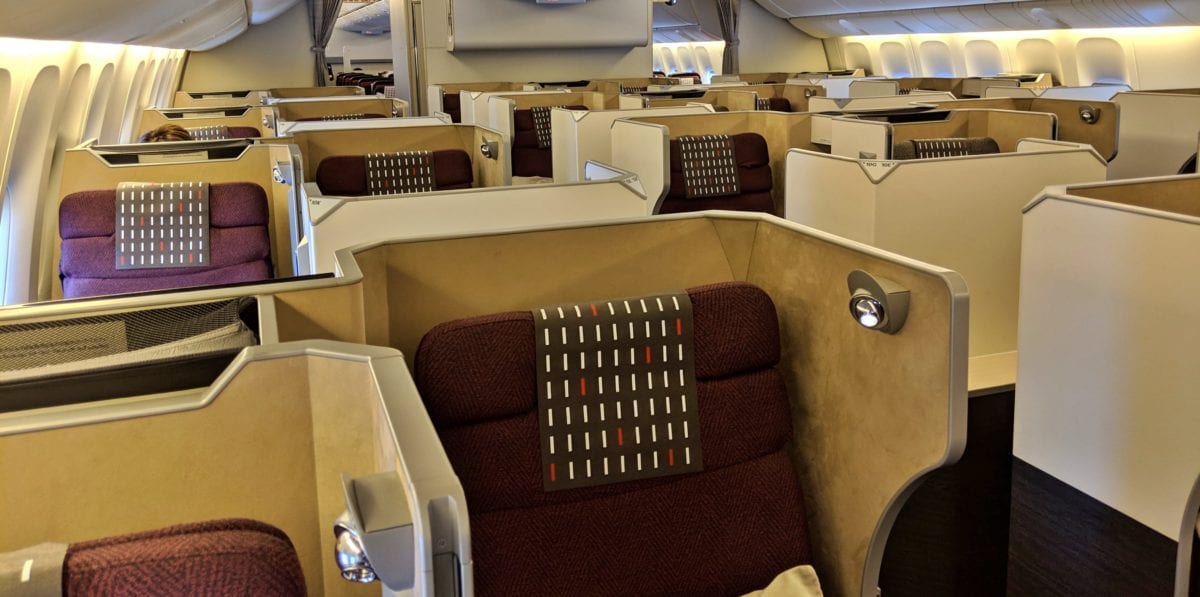Editor’s Note: Welcome to our Points Principles series, an ongoing series dedicated to explaining the basics behind the confusing world of frequent flyer miles and travel rewards points. Follow along as we lay out some of the building blocks to travel for nearly free. And check back to the Points Principles page to see what ground we’ve already covered.
Every traveler wants a big stash of points and miles. It's how you get there that's the problem.
The allure of free travel leads to poor decision making. Too many beginners start racking up miles willy-nilly, without regard for what they can actually best put to use.
So how do you decide which credit cards to open, or which miles to focus on earning? We're so glad you asked.
Think About Where You Live
Not all airline miles are created equally. And that's especially true depending on where you're based.
Don't chase after United MileagePlus miles if you don't live somewhere with a heavy United presence. If you live in Sioux Falls (FSD) South Dakota, collecting a bunch of Southwest Rapid Rewards miles generally won't do you much good … because Southwest doesn't fly there.
So consider what airlines are strong at your home airports as you start thinking of piling up miles through flying or credit cards. If you live outside of an airline's hub, every flight you take with that carrier will likely require a connection.
And when you're using miles, that's no fun. In some cases, it makes it harder to use those miles – or more expensive. As you're getting started with points and miles, you're far better off keeping things simple as you get the hang of it.
Opening an airline's co-branded credit card to earn miles is a great way to get started with points and miles. And as a bonus, these cards often come with valuable perks like free checked baggage and priority boarding. So if you find yourself flying one of your hometown airlines frequently, getting a free checked bag that typically costs $30 each way can add up fast.
But remember: Just because you have miles with one airline doesn't mean you can only use them for flights on that single airline. Delta SkyMiles aren't just good for flights on Delta. And some of the best ways to use American AAdvantage miles aren't on AA at all, but Japan Airlines, Qatar Airways, or Etihad.
This is where airline alliances and partnerships come in to make the airline miles you earn even more valuable. By leveraging these relationships, you can use your miles with one airline to book flights on dozens of different carriers. That means you can use United MileagePlus miles to book flights on dozens more Star Alliance partner carriers, like Lufthansa, EVA, Singapore Airlines, Turkish, and many more.
And the same is true for earning miles, too. These airline alliances and partnerships allow you to credit the miles you earn to your affiliated airline of choice. So you can still earn Delta SkyMiles when flying with Air France or KLM, for example.
Think About Your Travel Goals, Too
Every trip on your wishlist likely has a different (and better) way to get there using points and miles than the last.
So before you start opening credit cards or earning miles, it's critical to make a game plan. And the best way to do that is to work backward: Start with your travel goal to figure out which miles you need to best book it.
Want to book a trip to Hawaii for your family of four? Fly business class to Asia for two? A round-trip flight to Europe? Or just build up a cache of miles to use on shorter domestic trips?
Each of these goals likely requires a different plan. As your travel wishlist grows, so can your points and miles balance. But for most beginners, earning miles without a purpose is a recipe for waste.
Use tools like Awardhacker.com to find the best ways to get from Point A to Point B on miles, and how to earn them.
Focus on Flexible Points
Every newcomer to points and miles comes to a disturbing realization: You can't combine or transfer miles between airlines.
Sure, you can book flights on partner airlines with your Delta SkyMiles or American AAdvantage miles. But you can't combine the two currencies.
With credit card points, it's different. Credit card points can be many different things, and that flexibility is why they should definitely be on your earning wishlist.
While airline miles are stuck with their respective airlines, the credit card points you can earn from Chase, American Express, Citi, or Capital One are free agents. You can use them like cash toward your fare – a great way to book cheap flight deals – or you can transfer them to several different airline or hotel partners. That transferability is what sets credit card points apart from airline miles.
Let's look at our favorite card for any beginner as an example: the Chase Sapphire Preferred.
You earn 60,000 points after spending $4,000 within three months. From there, you've got options.
For starters, you can use Chase Ultimate Rewards points to book flights directly through Chase – and get a bonus when you do it. Every point is worth 1.25 cents toward your travel, which means your bonus is worth $750.
Or you could send your points to one of 12 different travel partners, like United Airlines, Virgin Atlantic, British Airways, Air France/KLM, and more.
| Program | Type | Transfer Ratio | Transfer Time |
|---|---|---|---|
| Aer Lingus | Airline | 1:1 | Instant |
| Air Canada Aeroplan | Airline | 1:1 | Instant |
| Air France/KLM | Airline | 1:1 | Instant |
| British Airways | Airline | 1:1 | Instant |
| Emirates | Airline | 1:1 | Instant |
| Iberia Plus | Airline | 1:1 | Instant |
| JetBlue | Airline | 1:1 | Instant |
| Singapore Air | Airline | 1:1 | 12-24 hours |
| Southwest Airlines | Airline | 1:1 | Instant |
| United Airlines | Airline | 1:1 | Instant |
| Virgin Atlantic | Airline | 1:1 | Instant |
| World of Hyatt | Hotel | 1:1 | Instant |
| IHG | Hotel | 1:1 | 1 day |
| Marriott Rewards | Hotel | 1:1 | 2 days |
In short, credit card points from banks like Chase can be (almost) anything you need them to be. So as your travel plans grow or change, you've got a balance to work with. And that's why they should vault to the top of your wishlist.
For example, let's say you're focused on racking up Delta SkyMiles when you start thinking about a flight to Hawaii. Delta's unpredictable award pricing often means that you may need to pay 50,000 miles or more. Live somewhere farther from the coast, or in a smaller town? That'll likely be 80,000 SkyMiles or more.
But if you've got Chase Ultimate Rewards points (or American Express Membership Rewards Points, or Citi ThankYou Points, or even Capital One Venture miles, for that matter), you're set. You could transfer those points to Air France/KLM FlyingBlue. Or find another sweet spot to get you to Hawaii on the cheap using miles.
What are the Most Valuable Points?
You want the points and miles that will get you the most. We get it.
Unfortunately, it's a very subjective question. Just what each currency is worth varies trip-by-trip, person-by-person. It depends on how you use them.
So while other travel sites will assign a specific value to every credit card point and airline mile, we don't. We think it's confusing and misleading.
Instead, here are some of the most valuable points and miles currencies out there:
American Express Membership Rewards: While Chase has the edge thanks to how great they are to book flights directly, American Express has some of the strongest transfer partners. Better yet, you can occasionally get bonus miles by cashing in on a special promotion, like a 30% bonus when transferring points to Virgin Atlantic earlier this year. Those are basically free airline miles, and they can’t be ignored.
Chase Ultimate Rewards: The Chase Sapphire Preferred is our #1 card for starters for a reason. The Chase Sapphire Reserve is our #1 overall travel rewards card for a reason. And that’s chiefly because these points are so valuable. Between some great transfer partners and the bonus you get when booking travel directly through Chase, they’re almost unbeatable.
Citi ThankYou Points: Citi ThankYou Points are still among the best out there, and the ability to transfer points to airlines and hotel chains gives you some great flexibility – as do occasional transfer bonuses like American Express offers. But their transfer partners aren’t nearly as strong as either American Express or Chase. And critically, there isn’t a U.S. airline to which you can transfer your ThankYou points.
Alaska Airlines Mileage Plan: If flying first or business class is on your bucket list, you need some Alaska Airlines miles. While transferring miles isn’t an option, Alaska miles are undoubtedly the most valuable among the dozens of airlines. Get this: It costs just 60,000 miles to fly business class from the U.S. to Tokyo or elsewhere in Asia. Want to fly Cathay Pacific First Class, one of the world’s most luxurious seats? You can do it – and enjoy $300 bottles of champagne – for just 70,000 Alaska miles.
Capital One: Capital One and its popular Venture card are a newcomer to the world of transferrable points. And despite the fact that these transfers aren’t the best – in most cases, you’ll get just 1.5 airline miles for every 2 points you transfer – Capital One points can still be very valuable. The ease of using them with the bank’s purchase eraser function just underscores that.
As you can see, transferrable credit card points get a major boost because of their flexibility. Alaska Airlines is the only airline mile that makes the cut in our top 5, thanks to its sweet spot for booking expensive first and business class seats using miles.
But Delta SkyMiles can also be great to have, especially for the frequent SkyMiles flash sales that can get you to the Caribbean for 12,000-plus SkyMiles or China for as low as 30,000 SkyMiles round-trip. So can American AAdvantage miles, thanks to the amazing partner airlines you can book with them. The list goes on.
Bottom Line
There's no one-size-fits-all answer for what miles or points are the best to earn. But we hope this guide gives you a good starting point to figure out what works best for your travels!





